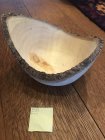That means that anchor seal is sure doing it’s job!Based only on what I've heard is it would not work very well. Turning wall thickness 1 inch or less seems to be optimum. There may be a way by waxing the end grain and allowing the moisture to come mainly from the face grain. But that is something I want to experiment with but have never had the chance. I did hope that green anchor sealed bowls could be dried using these beads but I tried that repeatedly at first and there was absolutely no water loss from any of my bowls that had been sealed completely with anchor seal (the original formula). None of our club members have communicated with me about drying un-turned blanks.
-
November 2025 Turning Challenge: Wall Hanging! (click here for details) -
Congratulations to Craig Morton, People's Choice in the October 2025 Turning Challenge (click here for details) -
Congratulations to Andy Chen for "Mesquite Vase with Polymer Clay Millefiori" being selected as Turning of the Week for November 3, 2025 (click here for details) -
Welcome new registering member. Your username must be your real First and Last name (for example: John Doe). "Screen names" and "handles" are not allowed and your registration will be deleted if you don't use your real name. Also, do not use all caps nor all lower case.
You are using an out of date browser. It may not display this or other websites correctly.
You should upgrade or use an alternative browser.
You should upgrade or use an alternative browser.
drying green wood turned bowls in Silica Desiccant beads?
- Thread starter Breck Whitworth
- Start date
- Joined
- Nov 1, 2013
- Messages
- 325
- Likes
- 739
- Location
- Gulfport, MS
- Website
- www.woodtreasuresbybreck.com
That is for sure, my normal way of slowing down the drying time for bowls using original formula anchor seal gives me about a 96% success rate from fatal cracks. The time tested slow drying works so well, I have no problem with it at all. The only reason I even tried the beads is because of those times after an art festival or a special Holliday where I've sold most of my inventory and need a few in a hurry lest I loose a sale or two. Some customers will wait the necessary months, but most want something for a gift now. It's like if I couldn't take credit cards I would loose 70% of my sales at certain events. The beads are an experiment to help provide that special piece a chance to be ready for sale Many Months before it would normally be ready. I love the problem of selling 85% of my inventory at one time, but some times my medium or large size bowls will all sell then 5 people want a medium or large size bowl after the event.
I've used silica beads for smaller bowls (8" or less) for over a year. None of them cracked. All of them stopped losing weight from moisture evaporation after about 2 - 3 days. I've come to the conclusion it's a great way to dry bowls, at least for a hobby oriented turner. If you turn a large number of bowls, it may not be practical as it would require a lot of beads, more than one container (or a large one), and frequent recharging of the beads. For me, though, it's a great idea that works for the periodic bowls I turn. I bought a "kit" from Rockler with the beads and an airtight container and 2 bags that can be sealed essentially airtight with a tie also included. I'm sure that there are cheaper sources for the beads and airtight containers, but this works great for a hobbyist who turns bowls once in awhile.
... One other thing that helped on my second wet magnolia bowl was to take it out of the beads after a period of time and let it rest or stabilize for a few hours. I then put it back in the beads and it dried very well. I don't use a moisture meter because I've turned so many bowls over the years I can tell like most of us when it is dry enough to finish turn by weight contrast to wet feel. Still experimenting but I am encouraged enough to try drying some money bowls soon.
Breck, if you have another green magnolia bowl the you might try combining a microwave and the silica beads like many do for drying flowers quickly. The microwave might help you avoid the resting period since it will cooking the water out with heat.
Wife gave me the url for instructions that she used for drying flowers after a recent funeral:
https://activaproducts.com/blogs/tips-tricks/the-easiest-way-to-dry-flowers-in-a-microwave
I generally don't rush drying on most pieces but when I do want to speed up the process, I have an old and large styrofoam cooler with the lightbulb/computer cooling fan method to make a kiln. This is used for rough turned pieces only because of the probable warping that will occur. I have done the microwave trick on some pieces but only small ones.
To dry wet turned pieces moderately fast I keep all the junkmail flyers I get in the mail. Those are seperated into single pages, crumpled into loose balls, packed around the wood piece and that all goes into a paper sack or cardboard box for larger pieces. I change out the flyers closest to the wood every day or every other day as the piece dries out some and stops loosing moisture rapidly. The flyers are free and I don't feel quite as bad about disposing of them after use. In fact, they can still be recylced after use.
To dry wet turned pieces moderately fast I keep all the junkmail flyers I get in the mail. Those are seperated into single pages, crumpled into loose balls, packed around the wood piece and that all goes into a paper sack or cardboard box for larger pieces. I change out the flyers closest to the wood every day or every other day as the piece dries out some and stops loosing moisture rapidly. The flyers are free and I don't feel quite as bad about disposing of them after use. In fact, they can still be recylced after use.
I use rechargeable beads to dry Norfolk Island Pine forms out all the time. Works fantastic on consistent thickness pieces and rarely causes any substantial cracking issues. I can go from green log to dry form in a couple of days. Results on your particular wood will vary and experimentation will be your key.
A experienced tip: Don't fill hollow forms completely when drying, I have had them burst forms. Instead I now fill partially and allow for bead expansion, flip the form and repeat, or rotate the form a bit throughout the shortened drying process.
A experienced tip: Don't fill hollow forms completely when drying, I have had them burst forms. Instead I now fill partially and allow for bead expansion, flip the form and repeat, or rotate the form a bit throughout the shortened drying process.
I've used it on a few bowls (species unk.). I used the SoPhresh crystals from Petco. I only had a crack (fixable) and it wasn't too bad. I turned them all pretty thin, though ( < 1/2) I put 6 inches of litter in the bottom of a 5 gallon pail, set a bowl in on its side, and then poured in litter so that all surfaces were touching litter. I took one out at 8 days, another at 10, and the last at 12.
- Joined
- Jul 18, 2018
- Messages
- 1,312
- Likes
- 2,814
- Location
- Baltimore, MD
- Website
- loujacobswoodturning.com
My club was offered a cut up backyard mulberry tree that the homeowner thought was mostly burls. Several of us jumped at it, but when we got there we felt it was more a matter of convoluted wood that was more just enfolded upon itself than true burls. Much of it was very insect eaten and rotten. We took it away in any case, and promised the homeowner and her neighbor, on whose property line the tree had lived, to make them each a bowl.
Here you can get an idea of what the material looked like:
I’ve had pretty bad luck finding any piece that I could get a decent sized bowl out of. After making two shallow 7” bowls, both of which cracked within a few days of rough turning, I did find one chunk that held promise for an 8” natural edge bowl. I turned it two days ago, and put it in a bag to begin drying, but then yesterday morning decided to try the desiccant method. In 24 hours it has lost almost 200 grams, going from an initial weight of 929 grams when just off the lathe, to 876 immediately before the desiccant, to now 697 grams - 75% of its initial weight. It is now fairly dry to the touch, and I’m wondering if it should continue in the desiccant, or if I’m risking any damage by letting it now air dry. It is about 3/8” uniform wall thickness. I’d love to hear your thoughts, especially if you’ve got experience with this method of drying.
wall thickness. I’d love to hear your thoughts, especially if you’ve got experience with this method of drying.
Here you can get an idea of what the material looked like:

I’ve had pretty bad luck finding any piece that I could get a decent sized bowl out of. After making two shallow 7” bowls, both of which cracked within a few days of rough turning, I did find one chunk that held promise for an 8” natural edge bowl. I turned it two days ago, and put it in a bag to begin drying, but then yesterday morning decided to try the desiccant method. In 24 hours it has lost almost 200 grams, going from an initial weight of 929 grams when just off the lathe, to 876 immediately before the desiccant, to now 697 grams - 75% of its initial weight. It is now fairly dry to the touch, and I’m wondering if it should continue in the desiccant, or if I’m risking any damage by letting it now air dry. It is about 3/8” uniform
 wall thickness. I’d love to hear your thoughts, especially if you’ve got experience with this method of drying.
wall thickness. I’d love to hear your thoughts, especially if you’ve got experience with this method of drying.I have seen videos on YouTube where Carl Jacobson dries his bowls in rice. He said it works very well.
